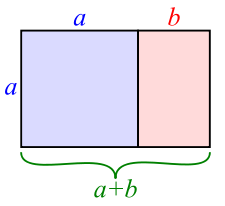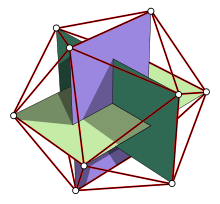Golden rectangle


In geometry, a golden rectangle is a rectangle whose side lengths are in the golden ratio,  , which is
, which is  (the Greek letter phi), where
(the Greek letter phi), where  is approximately 1.618.
is approximately 1.618.
Construction

A golden rectangle can be constructed with only straightedge and compass by four simple steps:
- Construct a simple square.
- Draw a line from the midpoint of one side of the square to an opposite corner.
- Use that line as the radius to draw an arc that defines the height of the rectangle.
- Complete the golden rectangle.
Relation to regular polygons and polyhedra
A distinctive feature of this shape is that when a square section is removed, the remainder is another golden rectangle; that is, with the same aspect ratio as the first. Square removal can be repeated infinitely, in which case corresponding corners of the squares form an infinite sequence of points on the golden spiral, the unique logarithmic spiral with this property.

An alternative construction of the golden rectangle uses three polygons circumscribed by congruent circles: a regular decagon, hexagon, and pentagon. The respective lengths a, b, and c of the sides of these three polygons satisfy the equation a2 + b2 = c2, so line segments with these lengths form a right triangle (by the converse of the Pythagorean theorem). The ratio of the side length of the hexagon to the decagon is the golden ratio, so this triangle forms half of a golden rectangle.[1]
The convex hull of two opposite edges of a regular icosahedron forms a golden rectangle. The twelve vertices of the icosahedron can be decomposed in this way into three mutually-perpendicular golden rectangles, whose boundaries are linked in the pattern of the Borromean rings.[2]
Applications
According to astrophysicist and mathematics popularizer Mario Livio, since the publication of Luca Pacioli's Divina Proportione in 1509,[3] when "with Pacioli's book, the Golden Ratio started to become available to artists in theoretical treatises that were not overly mathematical, that they could actually use,"[4] many artists and architects have been fascinated by the presumption that the golden rectangle is considered aesthetically pleasing. The proportions of the golden rectangle have been observed in works predating Pacioli's publication.[5]
- Le Corbusier's 1927 Villa Stein in Garches features a rectangular ground plan, elevation, and inner structure that closely approximate golden rectangles.[6]
See also
- Fibonacci numbers
- Golden mean
- Golden ratio
- Golden rhombus
- Kepler triangle
- Leonardo of Pisa
- Rabatment of the rectangle
- Silver ratio
References
- ↑ Euclid, Book XIII, Proposition 10.
- ↑ Burger, Edward B.; Starbird, Michael P. (2005). The Heart of Mathematics: An Invitation to Effective Thinking. Springer. p. 382. ISBN 9781931914413{{inconsistent citations}}.
- ↑ Pacioli, Luca. De divina proportione, Luca Paganinem de Paganinus de Brescia (Antonio Capella) 1509, Venice.
- ↑ Livio, Mario (2002). The Golden Ratio: The Story of Phi, The World's Most Astonishing Number. New York: Broadway Books. ISBN 0-7679-0815-5.
- ↑ Van Mersbergen, Audrey M., Rhetorical Prototypes in Architecture: Measuring the Acropolis with a Philosophical Polemic, Communication Quarterly, Vol. 46, 1998 ("a 'Golden Rectangle' has a ratio of the length of its sides equal to 1:1.61803+. The Parthenon is of these dimensions.")
- ↑ Le Corbusier, The Modulor, p. 35, as cited in Padovan, Richard, Proportion: Science, Philosophy, Architecture (1999), p. 320. Taylor & Francis. ISBN 0-419-22780-6: "Both the paintings and the architectural designs make use of the golden section".
External links
| Wikimedia Commons has media related to Golden rectangle. |
- Golden Ratio at MathWorld
- The Golden Mean and the Physics of Aesthetics
- Golden rectangle demonstration With interactive animation
| ||||||||
